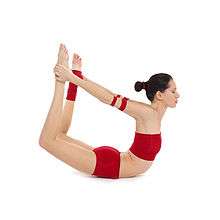Dhanurasana

Dhanurasana
Dhanurasana (DAH-noo-RAH-sah-nah[1]; Sanskrit: धनुरासन; IAST: Dhanurāsana), Bow Pose,[2] or sometimes Urdva Chakrasana (Upward Wheel Pose) is an asana.
Etymology
The name comes from the Sanskrit words Dhanura (धनुर, Dhanura) meaning "bow",[3] and Asana (आसन, Āsana) meaning "posture" or "seat".[4]
Description
First the practitioner should lie prone and grasp the feet to lift the leg and chest to form a bow. Remain in this position for some time and then return to the previous position.
Benefits
Benefits of Bow Pose (Dhanurāsana) [5]
- Strengthens the back and abdominal muscles.
- Stimulates the reproductive organs.
- Opens up the chest, neck and shoulders.
- Tones the leg and arm muscles.
- Adds greater flexibility to the back.
- Good stress and fatigue buster.
- Relieves menstrual discomfort and constipation.
- Helps people with renal (kidney) disorders.
- It provides relief from headache.
Anatomical focus
Backward extension of the spine is achieved with the back muscles, not by leverage with the arms.[5]
Follow-up asanas
Counter asanas are Halasana and Sarvangasana.[6]
See also
References
- ↑ Budilovsky, Joan; Adamson, Eve (2000). The complete idiot's guide to yoga (2 ed.). Penguin. p. 160. ISBN 978-0-02-863970-3. Retrieved 11 April 2011.
- ↑ "Yoga Journal - Bow Pose". Retrieved 2011-04-09.
- ↑ "Dhanurasana - AshtangaYoga.info". Retrieved 2011-04-11.
- ↑ Sinha, S.C. (1 June 1996). Dictionary of Philosophy. Anmol Publications PVT. LTD. p. 18. ISBN 978-81-7041-293-9. Retrieved 9 April 2011.
- 1 2 "Bow Pose - Dhanurasana - Yoga Pose". Yoga Journal. 2007-08-28. Retrieved 2016-12-04.
- ↑ "Langkawi Yoga - Chakrasana (Wheel pose)". Retrieved 2011-06-25.
Counter pose: Halasana or Sarvangasana
Further reading
- Iyengar, B. K. S. (1 October 2005). Illustrated Light On Yoga. HarperCollins. ISBN 978-81-7223-606-9. Retrieved 9 April 2011.
- Saraswati, Swami Satyananda (1 August 2003). Asana Pranayama Mudra Bandha. Nesma Books India. ISBN 978-81-86336-14-4. Retrieved 9 April 2011.
- Saraswati, Swami Satyananda (January 2004). A Systematic Course in the Ancient Tantric Techniques of Yoga and Kriya. Nesma Books India. ISBN 978-81-85787-08-4. Retrieved 9 April 2011.
This article is issued from Wikipedia - version of the 12/4/2016. The text is available under the Creative Commons Attribution/Share Alike but additional terms may apply for the media files.